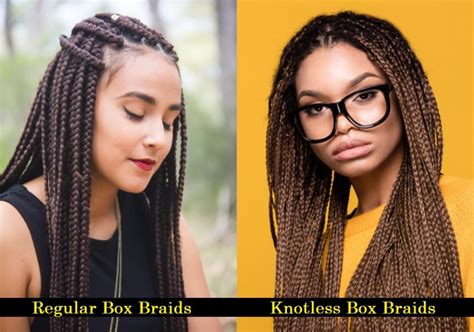Introduction
Protective hairstyles have become essential for individuals seeking to maintain healthy, luscious hair while experimenting with diverse styles. Among the most popular options are knotless braids and box braids, both offering unique advantages and drawbacks. This comprehensive guide will delve into the intricacies of each style, providing an in-depth comparison to help readers make an informed decision based on their individual needs and preferences.

Knotless Braids
Definition:
Knotless braids are a braiding technique that eliminates the need for knots at the root of the hair. Instead, the hair is fed through the braid in a continuous motion, resulting in a seamless and natural-looking finish.
Pros:
- Reduced Tension: By eliminating knots, knotless braids minimize tension on the hair and scalp, promoting hair health and reducing the risk of breakage.
- Scalp Comfort: The absence of knots makes knotless braids significantly more comfortable to wear for extended periods.
- Versatility: Knotless braids can be styled in various ways, including updos, buns, and ponytails, offering endless styling possibilities.
Cons:
- Time-Consuming: Knotless braids typically take longer to install than box braids due to their intricate technique.
- Skill Required: Knotless braids require a higher level of skill and precision to achieve a uniform and polished look.
- Maintenance: Knotless braids may require more frequent maintenance to keep the roots neat and prevent unraveling.
Box Braids
Definition:
Box braids involve parting the hair into square or rectangular sections and braiding each section tightly from root to tip. The braids are tied off at the end, creating a boxy shape.
Pros:
- Long-Lasting: Box braids are renowned for their durability and can last up to 8 weeks with proper care.
- Time-Saving: Box braids are generally faster to install than knotless braids due to their straightforward technique.
- Protective: Box braids effectively protect the hair from damage caused by heat, chemicals, and environmental factors.
Cons:
- Heavy: Box braids can be quite heavy, especially when installed with extensions, which can put strain on the hair and scalp.
- Damage: The tight braiding associated with box braids can lead to hair breakage if not installed carefully.
- Limited Styling Options: Box braids offer fewer styling possibilities compared to knotless braids due to their rigid structure.
Comparison Table 1: Key Differences
| Feature | Knotless Braids | Box Braids |
|---|---|---|
| Tension on Hair | Low | High |
| Scalp Comfort | High | Low |
| Versatility | High | Low |
| Time to Install | Long | Short |
| Skill Required | High | Low |
| Maintenance | Frequent | Less Frequent |
| Longevity | Medium (4-6 weeks) | Long (6-8 weeks) |
| Damage Risk | Low | Moderate |
| Styling Options | Extensive | Limited |
Common Mistakes to Avoid
Knotless Braids
- Braiding too tightly, which can cause breakage
- Leaving roots too loose, which can lead to unraveling
- Not using a rat-tail comb to separate the hair
Box Braids
- Using too much hair in each braid, which can make them heavy
- Braiding too close to the root, which can put strain on the hair
- Not securing the ends of the braids properly
How to: Step-by-Step Approach
Knotless Braids:
- Section the hair into small squares or diamonds.
- Feed the hair into a braid, adding extensions if desired.
- Continue braiding without creating knots at the root.
- Secure the ends with a rubber band or hair clip.
Box Braids:
- Create square or rectangular sections on the head.
- Braid each section tightly from root to tip.
- Tie off the ends with thread or elastic bands.
FAQs
-
Which style is better for my hair type?
– Knotless braids are recommended for fragile hair types prone to breakage.
– Box braids are suitable for most hair types, including thick and coarse hair. -
How long do these styles last?
– Knotless braids last for 4-6 weeks with proper care.
– Box braids can last up to 8 weeks. -
Can I wash my hair with these styles?
– Yes, both knotless and box braids can be washed with lukewarm water and sulfate-free shampoo. -
What is the best way to maintain these styles?
– Regularly oil the scalp and braids to prevent dryness.
– Re-tighten the roots as needed to keep the braids secure. -
How much do these styles cost?
– The cost varies depending on the length of the hair, the number of braids, and the location of the salon.
– On average, knotless braids range from $200-$500, while box braids can cost between $150-$400. -
Which style is more versatile?
– Knotless braids offer greater versatility due to their seamless appearance and ability to be styled in multiple ways. -
Which style causes less damage?
– Knotless braids generally cause less damage to the hair due to their reduced tension and knot-free technique. -
Which style is more comfortable to wear?
– Knotless braids are more comfortable to wear for extended periods due to their reduced tension on the scalp.
Conclusion
Both knotless braids and box braids offer unique advantages and disadvantages. Knotless braids provide a natural look, scalp comfort, and reduced damage, while box braids offer durability, protection, and a more traditional appearance. Ultimately, the best style for an individual depends on their personal preferences, hair type, and desired outcome. By understanding the key differences and following proper care instructions, anyone can achieve a stunning and protective hairstyle that complements their personal style.
